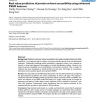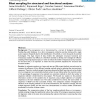148 search results - page 23 / 30 » The evolutionary capacity of protein structures |
BMCBI
2008
13 years 7 months ago
2008
Background: Prediction of protein solvent accessibility, also called accessible surface area (ASA) prediction, is an important step for tertiary structure prediction directly from...
BMCBI
2006
13 years 7 months ago
2006
Background: Several entropy-based methods have been developed for scoring sequence conservation in protein multiple sequence alignments. High scoring amino acid positions may corr...
BMCBI
2007
13 years 7 months ago
2007
Background: The post-genomic era is characterised by a torrent of biological information flooding the public databases. As a direct consequence, similarity searches starting with ...
BMCBI
2008
13 years 7 months ago
2008
Background: Identification of RNA homologs within genomic stretches is difficult when pairwise sequence identity is low or unalignable flanking residues are present. In both cases...
BMCBI
2006
13 years 7 months ago
2006
Background: More and more disordered regions have been discovered in protein sequences, and many of them are found to be functionally significant. Previous studies reveal that dis...


